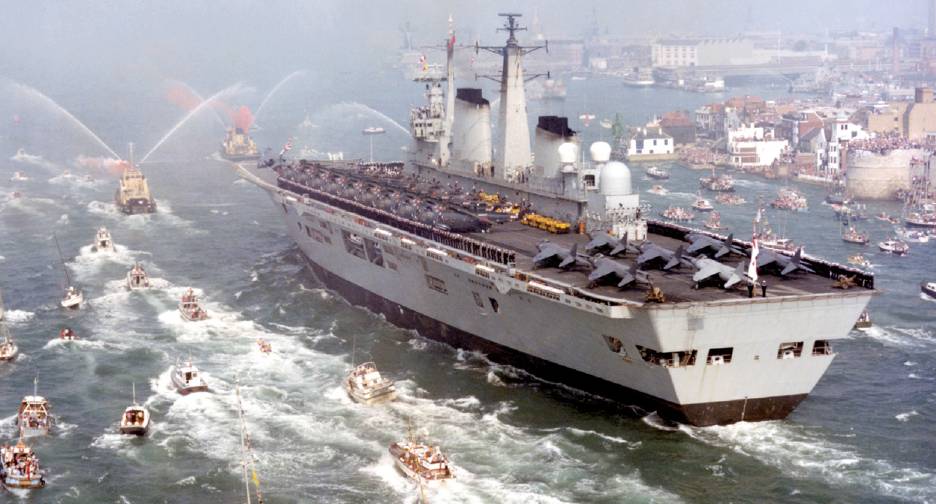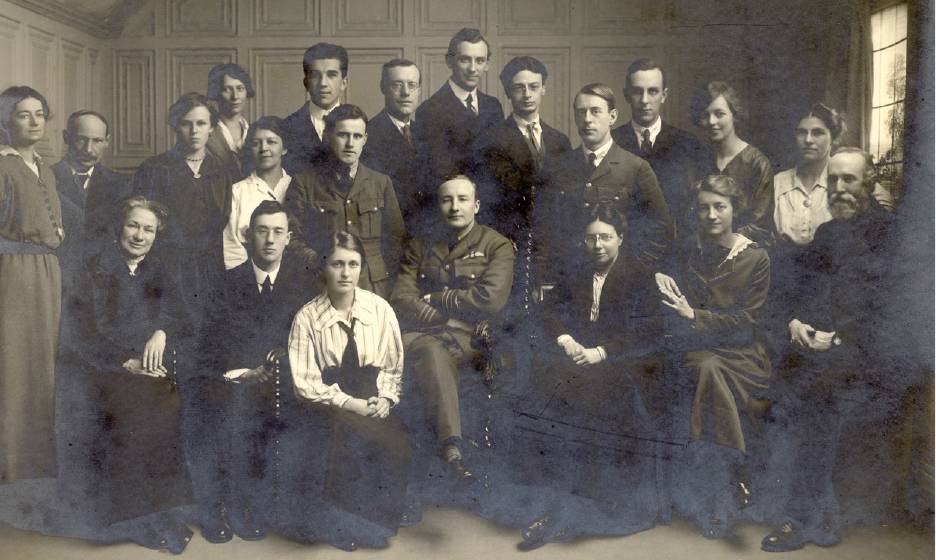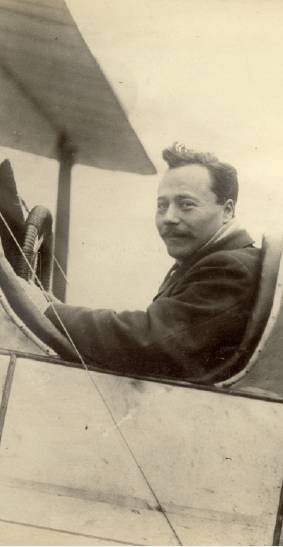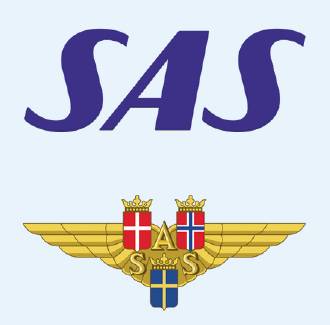Book Reviews
Book Reviews
HARRIER 809
Britain’s Legendary Jump Jet and the Untold Story of the Falklands War
By Rowland White
London: Bantam Press, 2020, pp482, £20.
 HMS Invincible returns to Portsmouth to celebrations following the Falklands Conflict in 1982. Lined up on deck are Sea King helicopters from 820 Naval Air Squadron and Sea Harrier FRS1 aircraft from 800 Naval Air Squadron. MoD/Crown copyright.
HMS Invincible returns to Portsmouth to celebrations following the Falklands Conflict in 1982. Lined up on deck are Sea King helicopters from 820 Naval Air Squadron and Sea Harrier FRS1 aircraft from 800 Naval Air Squadron. MoD/Crown copyright.
The Falklands War of 1982 represented a radical change in aerial conflict since WW2. Less than a decade after the end of Vietnam and the October War in the Middle East, the air war over the Falklands (Malvinas) was not a battle of Western aircraft and Soviet MiGs but between French, Israeli, and American jets on one side and arguably the least understood and appreciated British fighter of the Cold War on the other. How a handful of Harriers would fare in aerial combat nearly 8,000 miles away from their home in England against Daggers operating in Argentina’s front yard was as large an unknown in Washington DC as it was in Whitehall.
Since then, a number of excellent books have demonstrated that the Sea Harrier acquitted itself with distinction. Rowland White’s brilliant Harrier 809 goes far beyond these traditional narratives and technical analyses and is unquestionably both the best of the lot and an exemplar of what airpower history can be.
Written in an accessibly lucid, compelling style reminiscent of an action thriller, Harrier 809 is meticulously researched whether discussing technical details of the Blue Fox radar or Ministry decisions about who and what to deploy to the Falklands. The book is well presented with 60 brief chapters, multiple maps, three sections of photographs, helpful appendices, a short bibliography, and is fully indexed. Although we know the outcome of the war, White makes clear how precarious the British victory was. With perhaps one or two more Exocet missiles, Argentina easily could have emerged on top.
White’s inspired success with Harrier 809 comes from what is too often missing from aviation histories: the personal touch. Sea Harriers, Super Étendards, and Canberra PR9s don’t fly combat missions, pilots do. Frigates and aircraft carriers don’t fight for survival against Exocet missile attacks, captains, masters, and radar controllers do. For White, the story of the British victory in the Falklands is how the many different people involved pulled together a make-shift force of Harriers, equipped them with advanced AIM-9L Sidewinders (the ‘Mike Tyson’ of air-to-air missiles), and then coaxed everything possible out of them to provide the combat air patrols that kept the British task force alive.
Rowland White’s Harrier 809 is a masterpiece of airpower narrative and history and is unreservedly recommended
We share the disappointment of squadron mates and wives left behind, the exhilaration of aerial combat, the hope that every tactical decision is the right one, and the gut-wrenching agony of losing fellow pilots, both British and Argentine. We see the personalities of the aviators, sailors, commanders, and senior officers. Some are hard-drinking, pack-a-day, barf-and-a-cigarette-for-breakfast fighter pilots, some are pensive and reflect on the apparent futility of flying against a force numerically three times that of the Harriers. No matter which side White writes about, we quickly develop a personal interest in their success. Some we like, others leave us cold. In either case, they are all nearly larger than life. And it works.
Throughout the book, one has the feeling that White’s prose is, in fact, a retrospective play acted out at a quiet London club in front of a fireplace with each of the book’s many personalities from both sides sipping 30-year-old Scotch and wistfully recalling the events of 40 years ago as if they were yesterday. Harrier 809 is more a conversation among the participants than a mere transcript of events. Readers want to engage with both those who were there as well as White, as if to ask: “Was BLACK BUCK really the longest bombing mission in history” or to laugh out loud at the description of one pilot attempting to use the Sea Harrier’s navigation system as akin to “trying to work out your tax return on a calculator strapped to your ankle while driving around central Guildford at rush hour.”
Enjoying Harrier 809 over several evenings is as close as any reader – irrespective of interests – will ever get to those harrowing moments aboard and above HMS Invincible, HMS Hermes, or the ill-fated Atlantic Conveyor while strapped into a Sea Harrier on CAP or a Skyhawk pressing home a desperate attack. Rowland White’s Harrier 809 is a masterpiece of airpower narrative and history and is unreservedly recommended.
Dr Robert S Hopkins, III
FRAeS
Editor, Journal of Aeronautical History
THE FLYING MATHEMATICIANS OF WORLD WAR I
By Tony Royle
Montreal: McGill-Queen’s University Press, 2020, 288pp, £22.50.
 Admiralty Department 1918. Back Row: Miss Dorothy Chandler, Mr Solly Brant, Mr Hayward, John Case, H B Howard and Miss Lesley Hussey (later Mrs White). Middle Row: Miss Olive Moger, Mr Hunter, Miss Letitia Chitty, Mrs Fellows, Capt T M Wilson, Captain John Laurence Pritchard and Miss Norah Searle (Mrs H B Irving). Seated: Miss Myers, Alfred John Sutton Pippard, Miss Mary Hutchison, Commander Ogilvie, Miss Hilda P Hudson, Miss Amy M Trout and Mr Coates. RAeS (NAL).
Admiralty Department 1918. Back Row: Miss Dorothy Chandler, Mr Solly Brant, Mr Hayward, John Case, H B Howard and Miss Lesley Hussey (later Mrs White). Middle Row: Miss Olive Moger, Mr Hunter, Miss Letitia Chitty, Mrs Fellows, Capt T M Wilson, Captain John Laurence Pritchard and Miss Norah Searle (Mrs H B Irving). Seated: Miss Myers, Alfred John Sutton Pippard, Miss Mary Hutchison, Commander Ogilvie, Miss Hilda P Hudson, Miss Amy M Trout and Mr Coates. RAeS (NAL).
This book seeks to describe the development of aeronautics in the early years of the last century through the activities of almost 200 people who played a role, either directly, or indirectly, in the development of the aeroplane in the UK up to the end of the Great War. The title suggests that this is a story about ‘mathematicians’. However, if a ‘mathematician’ is someone who contributes to mathematics as a discipline and, especially, to the development of mathematical techniques, few of those described were really ‘mathematicians’ and of these not many actually flew.
It is clear from the early chapters that the aeroplane was developed by people who were motivated, primarily, by the need to fly, rather than a desire to understand the basic scientific principles. Arguably, the exception was Samuel Langley but he is only mentioned in passing. Like the steam engine, the aeroplane is a product of engineering – a discipline that creates useful things without needing a full understanding of the underlying science. Therefore, in this reviewer’s opinion, the majority of the people in the book are engineers and, while some may have studied mathematics, most simply used mathematics as an indispensable ‘tool of the trade’.
 Edward Teshmaker Busk (1886-1914) in an RE1 he was using for stability experiments. Busk was killed when the BE2c he was flying was engulfed in flames on 5 November 1914. RAeS (NAL)
Edward Teshmaker Busk (1886-1914) in an RE1 he was using for stability experiments. Busk was killed when the BE2c he was flying was engulfed in flames on 5 November 1914. RAeS (NAL)
The principal characters appear to be Edward Busk (Mechanics), Geoffrey Taylor (Maths and Physics), David Keith Lucas (Natural Sciences), Frederick Lindemann (Physics) and William Farren (Mechanics). These were the flyers and, tragically, Busk and Lucas were to be killed in flying accidents. However, by the above definition, none were ‘mathematicians’. Arguably, the three ladies who worked in the Technical Section of the Air Department of the Admiralty – Hilda Hudson, Letitia Chitty and Beatrice Cave-Brown-Cave were the closest fits to the definition of a professional mathematician. Their stories are both new and enlightening, but none of them flew. Hence, this reviewer’s issue with the title.
In the more general context, the book provides some useful information on the roles and contributions of some whose names are not well known, eg David Pinsent and Roderick Hill. The descriptions of the various organisations and the hints of rivalry are also interesting. However, for this reviewer, rather too much is said about those who, in reality, made little, or no, contribution, while too little is said about some who made significant advances in knowledge, eg Melvill Jones, Leonard Bairstow and Hermann Glauert. Also, the absence of any clear acknowledgement of the central role of Imperial College and of any discussion of pre-war, non-UK work, eg Ludwig Prandtl in Germany, makes the account feel lop-sided.
The author seems to have been particularly impressed with the role of the Cambridge Wranglers. However, in those days, only people of significant wealth could go to university and studying mathematics was definitely not a stepping stone to a career in any manufacturing industry. Therefore, it should be no surprise to learn that many of these socially privileged, mathematics graduates entered the higher echelons of the civil service and the armed forces, nor is it surprising that some applied their knowledge of the subject in the course of their daily work. The true value of the fundamental contributions of the most famous Wranglers – Stokes, Reynolds and Routh – was only realised much later, particularly, in the period following the development of digital computing.
On a more general note, considering the scope, the technical complexity and the size of the cast of characters, the book is very short and it is not an easy read. This is not helped by the author’s attempts to put some of the technical aspects into ‘layman’s terms’. The description of the concepts of aircraft ‘trim’, i.e. all forces and moments in balance, and static and dynamic ‘stability’, ie having the tendency to return smoothly to the original flight path following a disturbance, are seriously flawed; confusion surrounding the difference between a couple applied as a moment to induce bending and one applied as a torque to induce twist does not help.
When the author is discussing organisations and the roles of individuals, the text is both enjoyable and informative but the best parts are also the shortest. At times, it is thought provoking and, with the exception of those sections that purport to describe technical issues, it leaves the reader wanting to learn more about this critical period in the development of aeronautical engineering and the contributions of these fascinating people.
Professor Ian Poll
FRAeS
Past President
ROYAL VIKINGS
The Saga of Scandinavian Airlines and Predecessors
By Günter Endres
European Airlines, 2020, 262pp, £35.
 Top: The current SAS logo. Above: The airline’s original emblem, displaying each Scandinavian flag as coats of arms with surmounting crowns.
Top: The current SAS logo. Above: The airline’s original emblem, displaying each Scandinavian flag as coats of arms with surmounting crowns.
Günter Endres FRAeS is a formidable aviation historian with a whole shelf of well-researched titles to his name, from the aircraft-type specific Airbus A300 to more general reference titles such as British Aircraft Manufacturers since 1908 and World Airline Fleets. The subject of this review traces the long and complicated story of Scandinavian Airlines System, better known worldwide as SAS. ‘System’ is an apt description of this airline whose history resembles an hourglass; its many pre-war constituent parts, Danish, Norwegian and Swedish, were tightly corseted to become SAS after WW2 but, by the late 1950s the svelte consortium was beginning to bulge, launching many commuter and charter airlines, taking over domestic competitors, and participating overseas in Mexican and Thai carriers, later in Britain’s own British Midland Airways.
The initial chapters, pp 6-121, covers each country in turn, up to 1948, with comprehensive text, tabulated operating statistics and fleet details, many excellent photographs, some beautiful line drawings in colour, and a somewhat rudimentary map in each case.
As early as 1924 Denmark’s DDL was in talks with Sweden’s ABA about co-operation, at this stage with the backing of the German Junkers organisation but the Danes shied off and bought Fokkers instead. I was intrigued to learn that the early Danish registration letter was T which was later changed to the current OY following the redistribution of radio callsigns in the late 1920s. (In passing, it partly explains the Icelandic registration TF, as Iceland was ruled by Denmark until 1944.) Denmark later bought Junkers and Focke-Wulf Condors which saw limited war service; the sole remaining Condor re-established service to London in September 1945. Douglas DC-3s and Vickers Vikings made up the bulk of post-war purchases, continuing to fly in SAS colours after the initial co-operation agreement was signed in August 1946.
Norway came to aviation late, flying its Junkers Ju 52/3ms as floatplanes but had to stop operations during the war. With peace came orders for DC-3s and Short Sandringham flying boats, one of the latter surviving until 1955. SAS has never ever bought British-built aircraft but at least the Vikings and Sandringhams waved the flag a tiny bit.
Sweden’s story is the longest, reflecting the early adoption of air transport in this large and prosperous country that was backed initially by Junkers but ABA was one of the first European airlines to buy Douglas DC-3s, in 1937. Although Sweden was neutral during the war, it had by far the liveliest commercial activity of the three nations. ABA continued to fly to Germany, and, memorably, it operated 209 flights between Sweden and Scotland, using DC-3s and some of the 69 interned American Boeing B-17 bombers. Flight conditions were fraught and two of their DC-3s were shot down by the Luftwaffe. Astonishingly, Britain’s official war record Merchant Airmen makes no mention of the Swedish contribution to what became known as the Ball Bearing Run.
He is to be congratulated on successfully putting together this sumptuous and very accomplished history
The remaining pages are devoted to the formal establishment of SAS and its subsequent history, including 37 pages of fleet data. SAS continued the Douglas tradition for many decades, even using specially formulated DC-9s, before moving on to Airbuses and Boeings. It is no criticism of the author that the story does flag after SAS was granted its overseas monopoly concession by the three participating governments. The airline ventured across the Atlantic and the pioneering Polar flights across the Arctic are noteworthy, as is the early granting of overflight rights by the Russians, useful for the transit to Bangkok, a major centre of Danish and SAS investment. The first jets to be ordered were French-built Caravelles operated in co-operation with Swissair; some of them also saw service with Thai International.
Like many international airlines, SAS tried its hand at almost anything, not all of them successfully. I remember the SAS Hotel in Copenhagen, and the airline branched out into charter operations on several occasions, including the comically named Spanair and ‘snowflake’ brand; domestic competitors tended to be swallowed up and later regurgitated as yet another domestic brand or regional airline. Fortunately Mr Endres provides a helpful genealogy on p 139! By the end of the book all the different subsidiary brands have been closed down or absorbed; everything has been gathered into the SAS corset, except for Norway’s Widerøe which escaped from under in 2013.
There are some fine line drawings at the end of the section but do not be fooled by the Viscount; it was owned and operated by Fred Olsen, a Norwegian airline that had no problem using Viscounts and an Avro 748. Mr Endres passes no comment on the changes to the SAS livery over the years but the airline has consistently used the striking italic SAS logotype on the tail of its aircraft, even if other elements of the branding seem bizarre, none more so than the current pale beige-grey with invisible SAS logo in silver, and the word ‘Scandinavian’ painted on the bottom.
Mr Endres acknowledges the help he received from the SAS Historical Society and the SAS Museum, so I deduce that this is not an official SAS account. He is to be congratulated on successfully putting together this sumptuous and very accomplished history.
Guy Halford-MacLeod
FRAeS
 HMS Invincible returns to Portsmouth to celebrations following the Falklands Conflict in 1982. Lined up on deck are Sea King helicopters from 820 Naval Air Squadron and Sea Harrier FRS1 aircraft from 800 Naval Air Squadron. MoD/Crown copyright.
HMS Invincible returns to Portsmouth to celebrations following the Falklands Conflict in 1982. Lined up on deck are Sea King helicopters from 820 Naval Air Squadron and Sea Harrier FRS1 aircraft from 800 Naval Air Squadron. MoD/Crown copyright.

